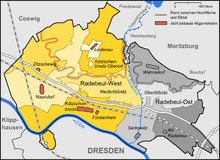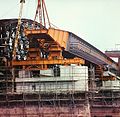Elbe bridges Niederwartha
The Elbe bridges Niederwartha are a railway bridge and a road bridge that cross the Elbe and connect the Dresden district of Niederwartha with Radebeul-Kötzschenbroda at a clear distance of 10 m .
Railway bridge
| Niederwartha railway bridge | |
|---|---|
| Technical specifications | |
| length | 353.6 m |
| Max. Span | 64 m |
| Superstructure width | |
| Superstructure height | 3.37 m |
| system | Steel box girder |
During the construction of the Berlin-Dresden Railway , the double-track railway overpass was built between 1873 and 1875. Three semi-parabolic diamond -shaped girders made of steel with spans of 62 m each spanned the Elbe, in the foreland there were 13 girder bridges with parallel truss girders, each 21 m wide. The bridge was also used by road traffic until 1945.
On the day of the German surrender , May 8, 1945, the bridge was blown up at 2 a.m. by a German Wehrmacht command and an SS unit to prevent Soviet shock troops from crossing over. Only the downstream, second superstructure remained badly damaged and could still be used by pedestrians. On July 31, 1945, an unmanned passenger train was supposed to cross the blocked bridge on a trial basis, but the bridge fell with the train into the Elbe. The stoker Mohr and an unknown Soviet soldier died, the train driver Haun survived to his misfortune, as he was subsequently imprisoned in a Soviet camp for sabotage despite petitions for clemency by 1,800 Dresden railway workers, where he died a short time later. The Elbe crossing was restored by a temporary pedestrian suspension bridge and made possible again some time later by the establishment of a ferry station. On April 13, 1946, a track over the structure was provisionally restored to such an extent that it could be used again. The bridge remained in this condition for 37 years until 1983.
Between 1977 and 1983 the old bridge was replaced by a new construction, which, in addition to two tracks, was also designed for a pedestrian and cycle path. A 353.5 m long girder bridge was built on the old pillars with a span of 22.75 m + 2x23.00 m + 23.50 m + 3x64.00 m + 23.50 m + 23.00 m + 22.75 m . The two superstructures over the Elbe are designed as 192 m long continuous beams . They consist of three-cell steel box girders with a construction height of 3.37 m. The approach bridges were built with pre-stressed concrete elements.
Road bridge
| Niederwartha road bridge | |
|---|---|
| Technical specifications | |
| length | 366 m |
| Max. Span | 192 m |
| Superstructure width | 12.5 m |
| Superstructure height | 2.0 m |
| Reinforcement | 1459 t |
| Bridge area | 4575 m² |
| system | Cable-stayed bridge |
In the course of the new construction of State Road 84 between Niederwartha and Meißen , the Elbe bridge was built downstream of the railway bridge. The structure has two lanes. Pedestrians and cyclists can still cross the Elbe on the neighboring railway bridge. Construction of the first cable-stayed bridge in Saxony began in 2006, and the 192 m long main bridge was completed at the end of 2008. The cost was around 20 million euros.
The bridge was opened to traffic on December 12, 2011. For reasons of flood protection, extensive subsequent rescheduling with work on a neighboring approach bridge (extension from 68 m to 112 m) and on the road connection was necessary, which delayed commissioning.
The steel construction of the Elbe bridge has a span of 82.5 m in the side span and, with a main opening of 192 m, is the longest cable-stayed bridge in Germany in composite construction. The pillars are in line with those of the railway bridge. The spans for the approach bridges are 22.0 m in the edge field and 23.0 m in the two following fields and finally 23.5 m (22.0 + 23.0 + 23.0 + 23.5 + 192.0 + 82 ,5 m). The bridge has a pylon on the right bank of the Elbe with a height of 77.25 m above ground, which can be accessed from the inside for inspection passages using ladders and platforms. Loads and tools for maintenance can be transported by means of a freight elevator, which is located in the upstream pylon stem. The 2.0 m high superstructure is braced over the pylon using nine pairs of cables. In the main opening, the superstructure consists of a steel composite cross-section with two 1.7 m high steel main girders and the 30 cm thick deck. The side field and the approach bridges were made of reinforced concrete .
literature
- Wolfgang Eilzer, Falk Richter, Torsten Wille, Ulrich Heymel, Christian Anistoroaiei: The Elbe bridge Niederwartha - the first cable-stayed bridge in Saxony. In: Steel construction. Vol. 75, Issue 2, 2006, ISSN 0038-9145 , pp. 93-104, doi: 10.1002 / stab.200610010 .
- Heinz Hoffmann: Radebeul railway history (= contributions to the urban culture of the city of Radebeul ). Association for monument preservation and new building, Radebeul 2006.
Web links
Individual evidence
- ↑ a b Frank Andert: Browsed through the archive - history from Radebeul. In: Preview and Review . Issue 4, 2005, ZDB -ID 1192547-4 .
- ↑ Bund der Antifaschisten Region Dresden eV (Ed.): Against forgetting. The days in May 1945 in Radebeul. Published on the occasion of the 60th anniversary of the liberation from Hitler fascism. Association of Antifascists Dresden Region, Radebeul 2005.
- ↑ Former Dresden "Geisterbrücke" is released , December 11th, 2011.
- ↑ ad-hoc-news.de: Bridge without connection in Niederwartha , May 22, 2009, 12:51 p.m. ( Memento from July 17, 2012 in the web archive archive.today )
| upstream | Bridges over the Elbe | downstream |
| Elbe Bridge Dresden (A 4) | Elbe bridges Niederwartha |
Elbe bridge Meißen (railway) |
Coordinates: 51 ° 5 ′ 47 ″ N , 13 ° 36 ′ 19 ″ E











